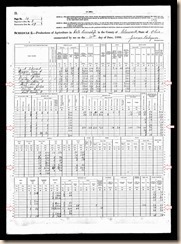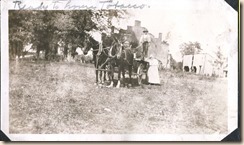On the Farm at Saltair in 1879 – 52 Ancestors # 39
I have written in passing in a number of posts about the Salt family farm and house in Saltair, Ohio. This time I want to capture a glimpse of the farm as it looked in 1879-1880, based on the agricultural schedule of the federal census, taken June 10, 1880. The agricultural schedules taken in 1880 included a goodly amount of information about the farm being reported on, so we have some idea of what the family members living there must have been doing on a daily basis.
The population schedule for 1880 shows that Ann J. Salt was the head of the household, and had three sons living with her. Actually two of them were her sons, John C., and Edward W., and the third listed as a son was Robert Justice, her young cousin (first cousin once removed) whose father had died in the Civil War and whose mother had remarried and left him on his own. Robert was listed as “without occupation”, so may have really only been visiting. Ann’s two sons were doing Farm Labor. There was also a 20 year old young woman listed as a servant.
As I noted briefly in writing about Ann’s afghan, the house was heated by wood burning fireplaces, and was likely lighted by gas or kerosene lanterns and lamps. There was certainly no electricity. Food would have been kept in an icebox if cooling was needed, and I know ice was cut and stored locally through this time. There was a smoke house behind the house, and hams etc. were smoked or cured there. The agricultural schedule gives us more about the farm and what they were growing etc.
For the year 1879, as enumerated on 10 Jun 1880, Ann J. Salt was the person who “conducts this farm” and the owner. She is highlighted on line 7.  She reported having a total of 430 acres of land, 50 of which were unimproved woodland/forest and 10 of which were other. Her improved land included 134 acres of tilled land and 236 acres of meadows, pastures, orchards/vineyards. The value of the farm, including land, fences and buildings was $13,000 while the value placed on the farm implements and machinery was $50, and the livestock was valued at $1320.
She reported having a total of 430 acres of land, 50 of which were unimproved woodland/forest and 10 of which were other. Her improved land included 134 acres of tilled land and 236 acres of meadows, pastures, orchards/vineyards. The value of the farm, including land, fences and buildings was $13,000 while the value placed on the farm implements and machinery was $50, and the livestock was valued at $1320.
The farm had 8 horses and 2 mules. These would have done the work of pulling machinery in the fields, as well as wagons, and provided transportation. There were 5 milk cows and 7 others with 5 calves having been dropped. Two cows were sold, probably 2 of the calves. From the milk, 200 pounds of butter had been made on the farm. Sheep on the farm as of June 1, 1880 totaled 275, including 120 lambs dropped. Changes over the time period had included the purchase of 200 sheep, the sale of 60, 10 killed by dogs and 20 had died of disease. From these sheep they had gotten 180 fleeces weighing 750 pounds. That seems like a lot, but I don’t know how it translated into yarns or threads. Also as of June 1, 1880, they had 60 swine and 72 barnyard poultry which had produced 50 dozen eggs in 1879. They had grown corn and oats and wheat that year. Potatoes and apples were grown (50 bushels of potatoes and 60 of apples). The largest crop, it looks to me, was tobacco: 18 acres had produced 12,000 pounds of tobacco. I don’t know how much, if any, of the eggs, potatoes and apples were sold; probably not much if any. The tobacco must have been the cash crop for the farm. This picture was probably taken between 1920 and 1922.
60 of apples). The largest crop, it looks to me, was tobacco: 18 acres had produced 12,000 pounds of tobacco. I don’t know how much, if any, of the eggs, potatoes and apples were sold; probably not much if any. The tobacco must have been the cash crop for the farm. This picture was probably taken between 1920 and 1922.

Leave a Reply